CHC30113 Certificate III: Assessment Workbook 1, Health and Safety
VerifiedAdded on 2022/11/16
|134
|20661
|26
Homework Assignment
AI Summary
This document is an assessment workbook for the CHC30113 Certificate III in Early Childhood Education and Care, focusing on Children's Health and Safety. It covers essential aspects of creating and maintaining a safe and healthy environment for children. The workbook includes a knowledge assessment with short answer questions, case studies requiring application of concepts to real-world scenarios, and a project involving establishing and maintaining a safe environment in a workplace setting. The content addresses topics such as workplace health and safety, hazard identification, emergency procedures, hygiene practices, and the implementation of safe practices, including the units of competency HLTWHS001 and CHCECE016. The workbook also provides information on competency-based assessment, principles of assessment, reasonable adjustments for learners with disabilities, and guidelines on plagiarism. This document is a valuable resource for students studying early childhood education, offering a comprehensive overview of health and safety requirements and assessment methods. The document is available on Desklib, a platform providing AI-based study tools and resources.
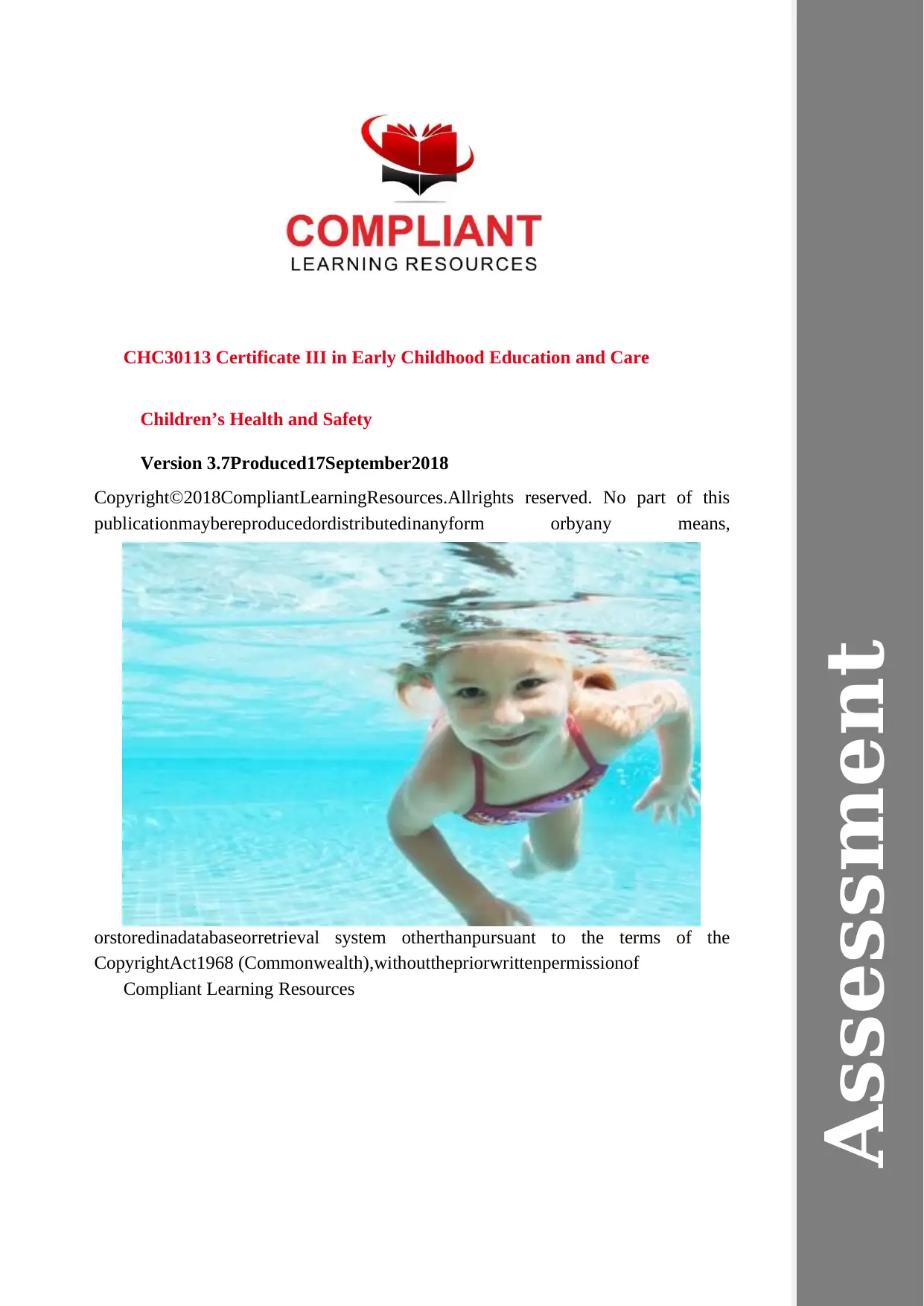
CHC30113 Certificate III in Early Childhood Education and Care
Children’s Health and Safety
Version 3.7Produced17September2018
Copyright©2018CompliantLearningResources.Allrights reserved. No part of this
publicationmaybereproducedordistributedinanyform orbyany means,
orstoredinadatabaseorretrieval system otherthanpursuant to the terms of the
CopyrightAct1968 (Commonwealth),withoutthepriorwrittenpermissionof
Compliant Learning Resources
Assessment
Children’s Health and Safety
Version 3.7Produced17September2018
Copyright©2018CompliantLearningResources.Allrights reserved. No part of this
publicationmaybereproducedordistributedinanyform orbyany means,
orstoredinadatabaseorretrieval system otherthanpursuant to the terms of the
CopyrightAct1968 (Commonwealth),withoutthepriorwrittenpermissionof
Compliant Learning Resources
Assessment
Paraphrase This Document
Need a fresh take? Get an instant paraphrase of this document with our AI Paraphraser
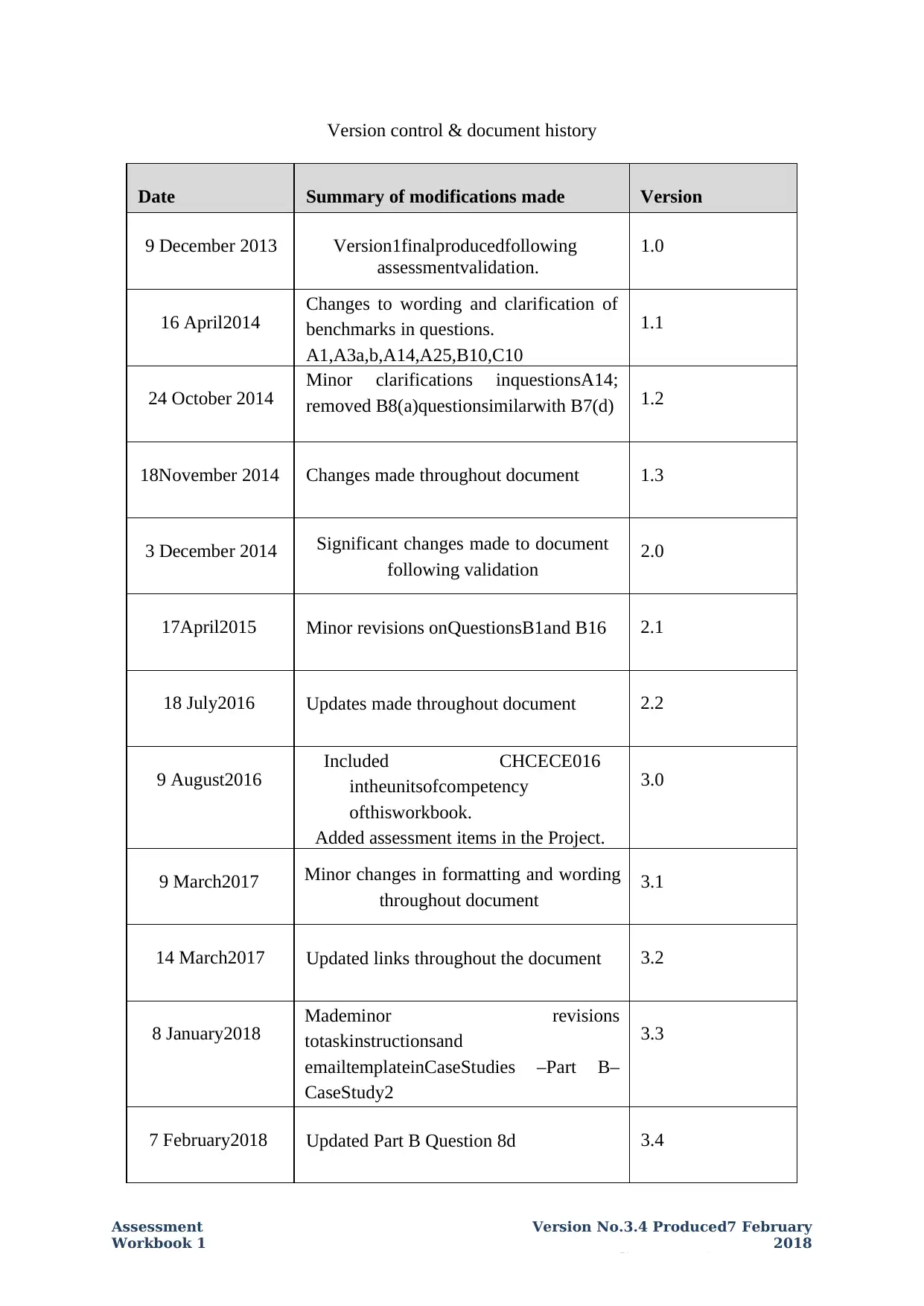
Assessment
Workbook 1
Page 2
Version No.3.4 Produced7 February
2018
© Compliant LearningResources
Version control & document history
Date Summary of modifications made Version
9 December 2013 Version1finalproducedfollowing
assessmentvalidation.
1.0
16 April2014 Changes to wording and clarification of
benchmarks in questions.
A1,A3a,b,A14,A25,B10,C10
1.1
24 October 2014 Minor clarifications inquestionsA14;
removed B8(a)questionsimilarwith B7(d) 1.2
18November 2014 Changes made throughout document 1.3
3 December 2014 Significant changes made to document
following validation
2.0
17April2015 Minor revisions onQuestionsB1and B16 2.1
18 July2016 Updates made throughout document 2.2
9 August2016 Included CHCECE016
intheunitsofcompetency
ofthisworkbook.
Added assessment items in the Project.
3.0
9 March2017 Minor changes in formatting and wording
throughout document
3.1
14 March2017 Updated links throughout the document 3.2
8 January2018 Mademinor revisions
totaskinstructionsand
emailtemplateinCaseStudies –Part B–
CaseStudy2
3.3
7 February2018 Updated Part B Question 8d 3.4
Workbook 1
Page 2
Version No.3.4 Produced7 February
2018
© Compliant LearningResources
Version control & document history
Date Summary of modifications made Version
9 December 2013 Version1finalproducedfollowing
assessmentvalidation.
1.0
16 April2014 Changes to wording and clarification of
benchmarks in questions.
A1,A3a,b,A14,A25,B10,C10
1.1
24 October 2014 Minor clarifications inquestionsA14;
removed B8(a)questionsimilarwith B7(d) 1.2
18November 2014 Changes made throughout document 1.3
3 December 2014 Significant changes made to document
following validation
2.0
17April2015 Minor revisions onQuestionsB1and B16 2.1
18 July2016 Updates made throughout document 2.2
9 August2016 Included CHCECE016
intheunitsofcompetency
ofthisworkbook.
Added assessment items in the Project.
3.0
9 March2017 Minor changes in formatting and wording
throughout document
3.1
14 March2017 Updated links throughout the document 3.2
8 January2018 Mademinor revisions
totaskinstructionsand
emailtemplateinCaseStudies –Part B–
CaseStudy2
3.3
7 February2018 Updated Part B Question 8d 3.4

Assessment Workbook 1
© Compliant Learning
Resources
Version No.3.7Produced17 September
2018
Page3
21May2018 NQS Updates 3.5
29 May2018 Updated Meal Template 3.6
17September 2018 updatedKnowledgeAssessmentPartAQues
tion19f 3.7
© Compliant Learning
Resources
Version No.3.7Produced17 September
2018
Page3
21May2018 NQS Updates 3.5
29 May2018 Updated Meal Template 3.6
17September 2018 updatedKnowledgeAssessmentPartAQues
tion19f 3.7
⊘ This is a preview!⊘
Do you want full access?
Subscribe today to unlock all pages.

Trusted by 1+ million students worldwide
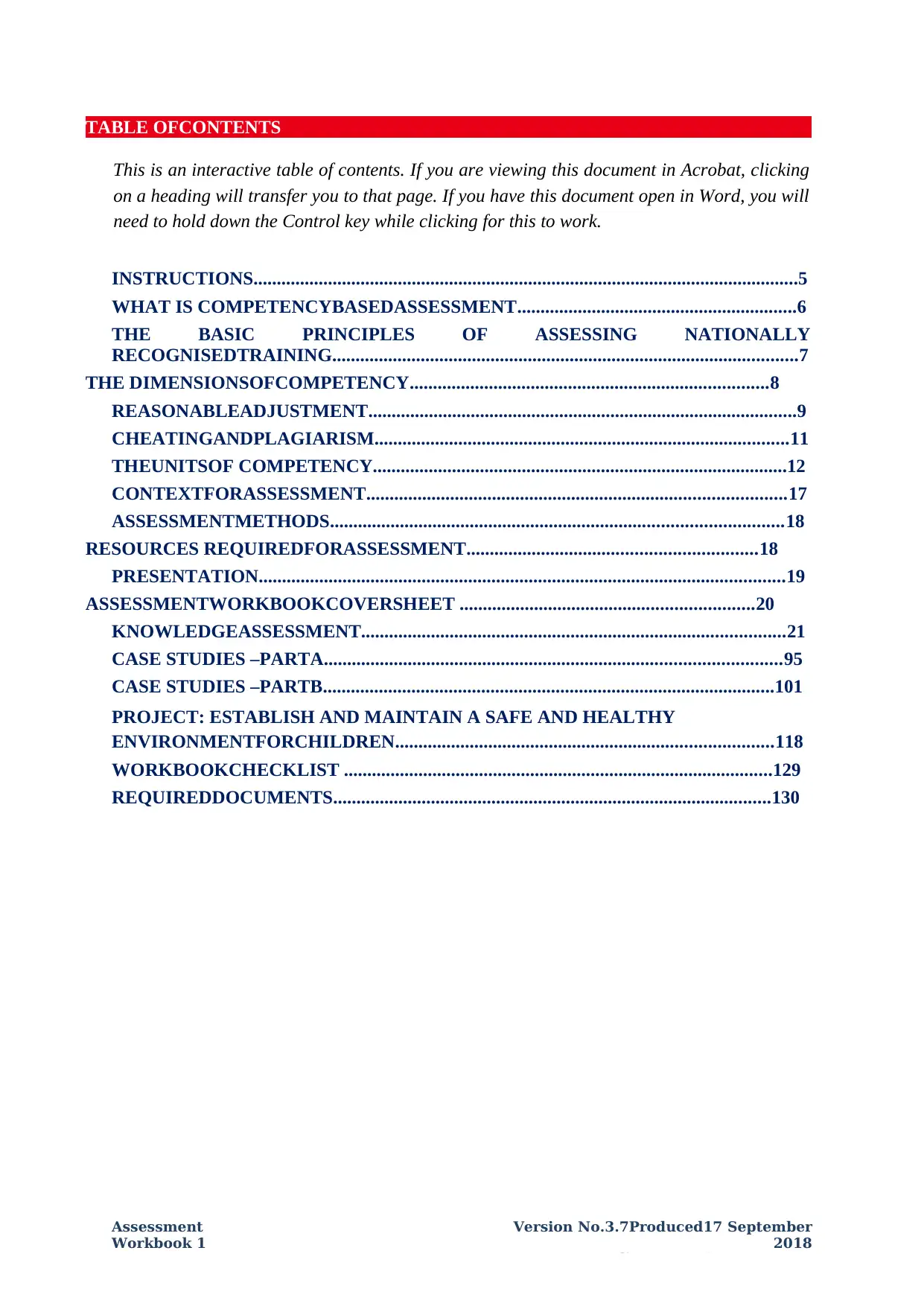
Assessment
Workbook 1
Page 4
Version No.3.7Produced17 September
2018
© Compliant LearningResources
TABLE OFCONTENTS
This is an interactive table of contents. If you are viewing this document in Acrobat, clicking
on a heading will transfer you to that page. If you have this document open in Word, you will
need to hold down the Control key while clicking for this to work.
INSTRUCTIONS.....................................................................................................................5
WHAT IS COMPETENCYBASEDASSESSMENT............................................................6
THE BASIC PRINCIPLES OF ASSESSING NATIONALLY
RECOGNISEDTRAINING....................................................................................................7
THE DIMENSIONSOFCOMPETENCY.............................................................................8
REASONABLEADJUSTMENT............................................................................................9
CHEATINGANDPLAGIARISM.........................................................................................11
THEUNITSOF COMPETENCY.........................................................................................12
CONTEXTFORASSESSMENT..........................................................................................17
ASSESSMENTMETHODS.................................................................................................18
RESOURCES REQUIREDFORASSESSMENT..............................................................18
PRESENTATION.................................................................................................................19
ASSESSMENTWORKBOOKCOVERSHEET ...............................................................20
KNOWLEDGEASSESSMENT...........................................................................................21
CASE STUDIES –PARTA..................................................................................................95
CASE STUDIES –PARTB.................................................................................................101
PROJECT: ESTABLISH AND MAINTAIN A SAFE AND HEALTHY
ENVIRONMENTFORCHILDREN.................................................................................118
WORKBOOKCHECKLIST ............................................................................................129
REQUIREDDOCUMENTS..............................................................................................130
Workbook 1
Page 4
Version No.3.7Produced17 September
2018
© Compliant LearningResources
TABLE OFCONTENTS
This is an interactive table of contents. If you are viewing this document in Acrobat, clicking
on a heading will transfer you to that page. If you have this document open in Word, you will
need to hold down the Control key while clicking for this to work.
INSTRUCTIONS.....................................................................................................................5
WHAT IS COMPETENCYBASEDASSESSMENT............................................................6
THE BASIC PRINCIPLES OF ASSESSING NATIONALLY
RECOGNISEDTRAINING....................................................................................................7
THE DIMENSIONSOFCOMPETENCY.............................................................................8
REASONABLEADJUSTMENT............................................................................................9
CHEATINGANDPLAGIARISM.........................................................................................11
THEUNITSOF COMPETENCY.........................................................................................12
CONTEXTFORASSESSMENT..........................................................................................17
ASSESSMENTMETHODS.................................................................................................18
RESOURCES REQUIREDFORASSESSMENT..............................................................18
PRESENTATION.................................................................................................................19
ASSESSMENTWORKBOOKCOVERSHEET ...............................................................20
KNOWLEDGEASSESSMENT...........................................................................................21
CASE STUDIES –PARTA..................................................................................................95
CASE STUDIES –PARTB.................................................................................................101
PROJECT: ESTABLISH AND MAINTAIN A SAFE AND HEALTHY
ENVIRONMENTFORCHILDREN.................................................................................118
WORKBOOKCHECKLIST ............................................................................................129
REQUIREDDOCUMENTS..............................................................................................130
Paraphrase This Document
Need a fresh take? Get an instant paraphrase of this document with our AI Paraphraser

Assessment Workbook 1
© Compliant Learning
Resources
Version No.3.7Produced17 September
2018
Page5
INSTRUCTIONS
The questions in the Knowledge Assessment are all in a short answer format. They
addresstheunderpinningknowledgeandconceptsrelevanttotheunitsofcompetency in thissubject.
CaseStudiesarelongerquestionsrequiringcreativethoughtprocessesandapplication of concepts
to theoretical situations, while the Project sets out tasks to be delivered in an actual
workplacesetting.
Where applicable, you must answer all questions using your own words. However you
may reference your learner guide, and other online or hard copy resources to complete this
assessment.
You must attempt all assessments satisfactorily to achieve an overall award of competent.
Re-read the section on Plagiarism and Copying in your Welcome pack.
IfyouarecurrentlyworkingaspartofanEarlyChildhoodEducation/ChildCareteam, you may
answer these questions based on your own workplace. Otherwise consider
whatyoushoulddoifyouwereworkingaspartofanEarlyChildhoodEducation/Child Care team
you may refer to Sparkling Stars as anexample.
© Compliant Learning
Resources
Version No.3.7Produced17 September
2018
Page5
INSTRUCTIONS
The questions in the Knowledge Assessment are all in a short answer format. They
addresstheunderpinningknowledgeandconceptsrelevanttotheunitsofcompetency in thissubject.
CaseStudiesarelongerquestionsrequiringcreativethoughtprocessesandapplication of concepts
to theoretical situations, while the Project sets out tasks to be delivered in an actual
workplacesetting.
Where applicable, you must answer all questions using your own words. However you
may reference your learner guide, and other online or hard copy resources to complete this
assessment.
You must attempt all assessments satisfactorily to achieve an overall award of competent.
Re-read the section on Plagiarism and Copying in your Welcome pack.
IfyouarecurrentlyworkingaspartofanEarlyChildhoodEducation/ChildCareteam, you may
answer these questions based on your own workplace. Otherwise consider
whatyoushoulddoifyouwereworkingaspartofanEarlyChildhoodEducation/Child Care team
you may refer to Sparkling Stars as anexample.
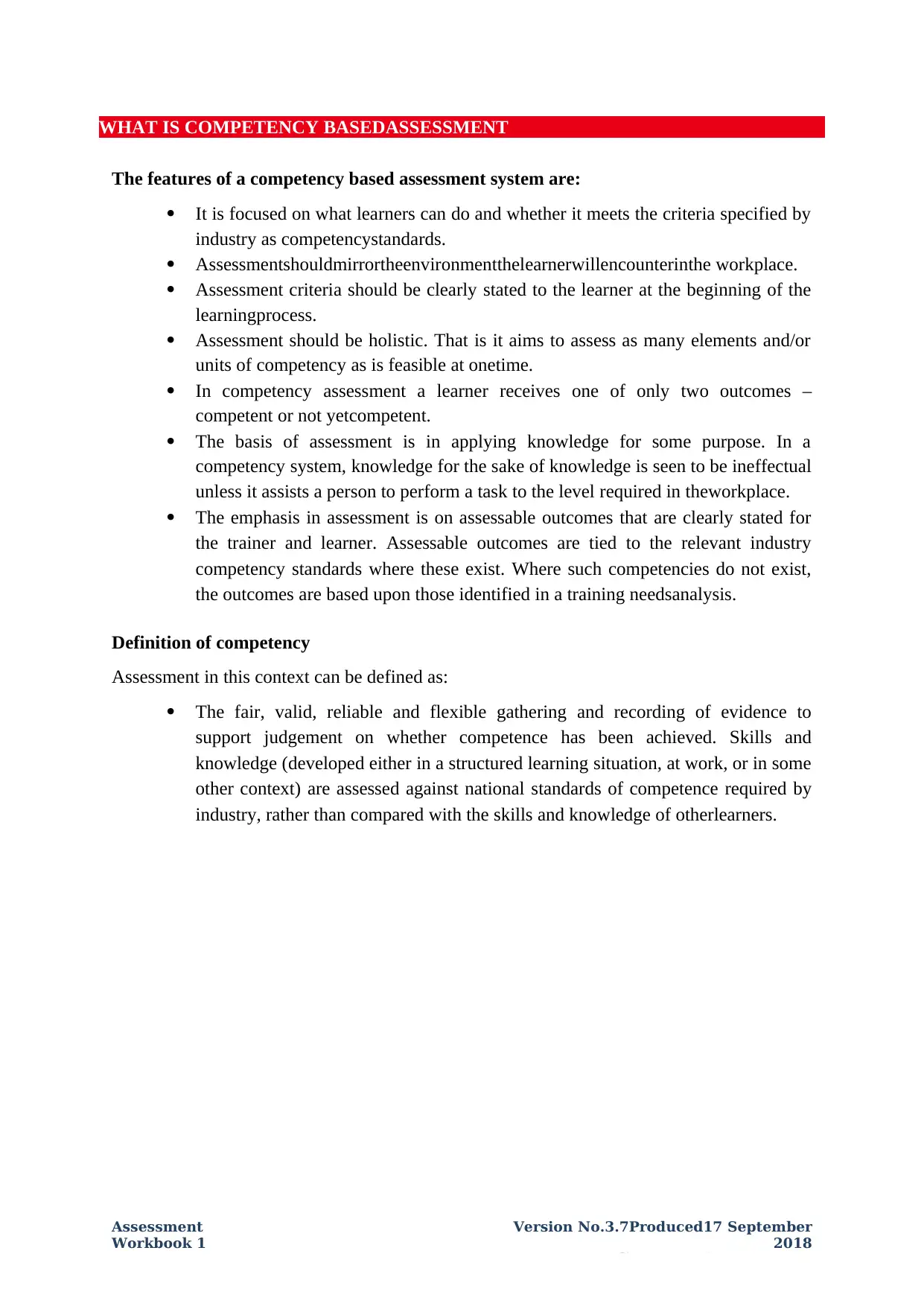
Assessment
Workbook 1
Page 6
Version No.3.7Produced17 September
2018
© Compliant LearningResources
WHAT IS COMPETENCY BASEDASSESSMENT
The features of a competency based assessment system are:
It is focused on what learners can do and whether it meets the criteria specified by
industry as competencystandards.
Assessmentshouldmirrortheenvironmentthelearnerwillencounterinthe workplace.
Assessment criteria should be clearly stated to the learner at the beginning of the
learningprocess.
Assessment should be holistic. That is it aims to assess as many elements and/or
units of competency as is feasible at onetime.
In competency assessment a learner receives one of only two outcomes –
competent or not yetcompetent.
The basis of assessment is in applying knowledge for some purpose. In a
competency system, knowledge for the sake of knowledge is seen to be ineffectual
unless it assists a person to perform a task to the level required in theworkplace.
The emphasis in assessment is on assessable outcomes that are clearly stated for
the trainer and learner. Assessable outcomes are tied to the relevant industry
competency standards where these exist. Where such competencies do not exist,
the outcomes are based upon those identified in a training needsanalysis.
Definition of competency
Assessment in this context can be defined as:
The fair, valid, reliable and flexible gathering and recording of evidence to
support judgement on whether competence has been achieved. Skills and
knowledge (developed either in a structured learning situation, at work, or in some
other context) are assessed against national standards of competence required by
industry, rather than compared with the skills and knowledge of otherlearners.
Workbook 1
Page 6
Version No.3.7Produced17 September
2018
© Compliant LearningResources
WHAT IS COMPETENCY BASEDASSESSMENT
The features of a competency based assessment system are:
It is focused on what learners can do and whether it meets the criteria specified by
industry as competencystandards.
Assessmentshouldmirrortheenvironmentthelearnerwillencounterinthe workplace.
Assessment criteria should be clearly stated to the learner at the beginning of the
learningprocess.
Assessment should be holistic. That is it aims to assess as many elements and/or
units of competency as is feasible at onetime.
In competency assessment a learner receives one of only two outcomes –
competent or not yetcompetent.
The basis of assessment is in applying knowledge for some purpose. In a
competency system, knowledge for the sake of knowledge is seen to be ineffectual
unless it assists a person to perform a task to the level required in theworkplace.
The emphasis in assessment is on assessable outcomes that are clearly stated for
the trainer and learner. Assessable outcomes are tied to the relevant industry
competency standards where these exist. Where such competencies do not exist,
the outcomes are based upon those identified in a training needsanalysis.
Definition of competency
Assessment in this context can be defined as:
The fair, valid, reliable and flexible gathering and recording of evidence to
support judgement on whether competence has been achieved. Skills and
knowledge (developed either in a structured learning situation, at work, or in some
other context) are assessed against national standards of competence required by
industry, rather than compared with the skills and knowledge of otherlearners.
⊘ This is a preview!⊘
Do you want full access?
Subscribe today to unlock all pages.

Trusted by 1+ million students worldwide
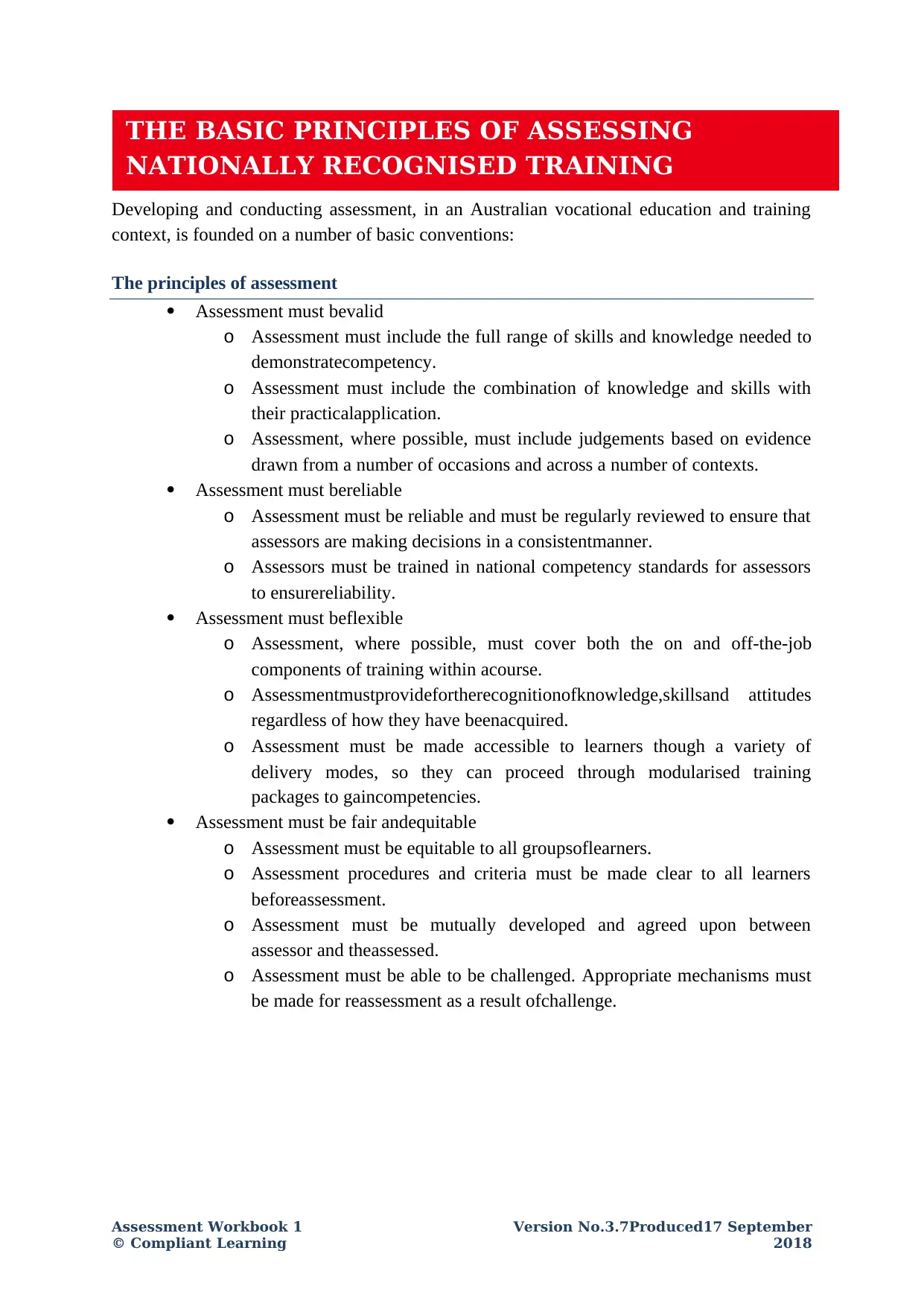
Assessment Workbook 1
© Compliant Learning
Resources
Version No.3.7Produced17 September
2018
Page7
THE BASIC PRINCIPLES OF ASSESSING
NATIONALLY RECOGNISED TRAINING
Developing and conducting assessment, in an Australian vocational education and training
context, is founded on a number of basic conventions:
The principles of assessment
Assessment must bevalid
o Assessment must include the full range of skills and knowledge needed to
demonstratecompetency.
o Assessment must include the combination of knowledge and skills with
their practicalapplication.
o Assessment, where possible, must include judgements based on evidence
drawn from a number of occasions and across a number of contexts.
Assessment must bereliable
o Assessment must be reliable and must be regularly reviewed to ensure that
assessors are making decisions in a consistentmanner.
o Assessors must be trained in national competency standards for assessors
to ensurereliability.
Assessment must beflexible
o Assessment, where possible, must cover both the on and off-the-job
components of training within acourse.
o Assessmentmustprovidefortherecognitionofknowledge,skillsand attitudes
regardless of how they have beenacquired.
o Assessment must be made accessible to learners though a variety of
delivery modes, so they can proceed through modularised training
packages to gaincompetencies.
Assessment must be fair andequitable
o Assessment must be equitable to all groupsoflearners.
o Assessment procedures and criteria must be made clear to all learners
beforeassessment.
o Assessment must be mutually developed and agreed upon between
assessor and theassessed.
o Assessment must be able to be challenged. Appropriate mechanisms must
be made for reassessment as a result ofchallenge.
© Compliant Learning
Resources
Version No.3.7Produced17 September
2018
Page7
THE BASIC PRINCIPLES OF ASSESSING
NATIONALLY RECOGNISED TRAINING
Developing and conducting assessment, in an Australian vocational education and training
context, is founded on a number of basic conventions:
The principles of assessment
Assessment must bevalid
o Assessment must include the full range of skills and knowledge needed to
demonstratecompetency.
o Assessment must include the combination of knowledge and skills with
their practicalapplication.
o Assessment, where possible, must include judgements based on evidence
drawn from a number of occasions and across a number of contexts.
Assessment must bereliable
o Assessment must be reliable and must be regularly reviewed to ensure that
assessors are making decisions in a consistentmanner.
o Assessors must be trained in national competency standards for assessors
to ensurereliability.
Assessment must beflexible
o Assessment, where possible, must cover both the on and off-the-job
components of training within acourse.
o Assessmentmustprovidefortherecognitionofknowledge,skillsand attitudes
regardless of how they have beenacquired.
o Assessment must be made accessible to learners though a variety of
delivery modes, so they can proceed through modularised training
packages to gaincompetencies.
Assessment must be fair andequitable
o Assessment must be equitable to all groupsoflearners.
o Assessment procedures and criteria must be made clear to all learners
beforeassessment.
o Assessment must be mutually developed and agreed upon between
assessor and theassessed.
o Assessment must be able to be challenged. Appropriate mechanisms must
be made for reassessment as a result ofchallenge.
Paraphrase This Document
Need a fresh take? Get an instant paraphrase of this document with our AI Paraphraser

Assessment
Workbook 1
Page 8
Version No.3.7Produced17 September
2018
© Compliant LearningResources
The rules of evidence (from Training in Australia by M Tovey, D Lawlor)
When collecting evidence there are certain rules that apply to that evidence. All evidence
must be valid, sufficient, authentic and current;
Valid
o Evidence gathered should meet the requirements of the unit of
competency. This evidence should match, or at least reflect, the type of
performance that is to be assessed, whether it covers knowledge, skills
orattitudes.
Sufficient
o This rule relates to the amount of evidence gathered. It is imperative
thatenoughevidenceisgatheredtosatisfytherequirementsthatthe learner is
competent across all aspects of the unit ofcompetency.
Authentic
o When evidence is gathered, the assessor must be satisfied that evidence is
the learner’s ownwork.
Current
o This relates to the recency of the evidence and whether the evidence
relates to currentabilities.
THE DIMENSIONS OFCOMPETENCY
Thenationalconceptofcompetencyincludesallaspectsofworkperformance,andnot only narrow task
skills. The four dimensions of competencyare:
Taskskills
Task managementskills
Contingency managementskills
Job role and environmentskills
Workbook 1
Page 8
Version No.3.7Produced17 September
2018
© Compliant LearningResources
The rules of evidence (from Training in Australia by M Tovey, D Lawlor)
When collecting evidence there are certain rules that apply to that evidence. All evidence
must be valid, sufficient, authentic and current;
Valid
o Evidence gathered should meet the requirements of the unit of
competency. This evidence should match, or at least reflect, the type of
performance that is to be assessed, whether it covers knowledge, skills
orattitudes.
Sufficient
o This rule relates to the amount of evidence gathered. It is imperative
thatenoughevidenceisgatheredtosatisfytherequirementsthatthe learner is
competent across all aspects of the unit ofcompetency.
Authentic
o When evidence is gathered, the assessor must be satisfied that evidence is
the learner’s ownwork.
Current
o This relates to the recency of the evidence and whether the evidence
relates to currentabilities.
THE DIMENSIONS OFCOMPETENCY
Thenationalconceptofcompetencyincludesallaspectsofworkperformance,andnot only narrow task
skills. The four dimensions of competencyare:
Taskskills
Task managementskills
Contingency managementskills
Job role and environmentskills
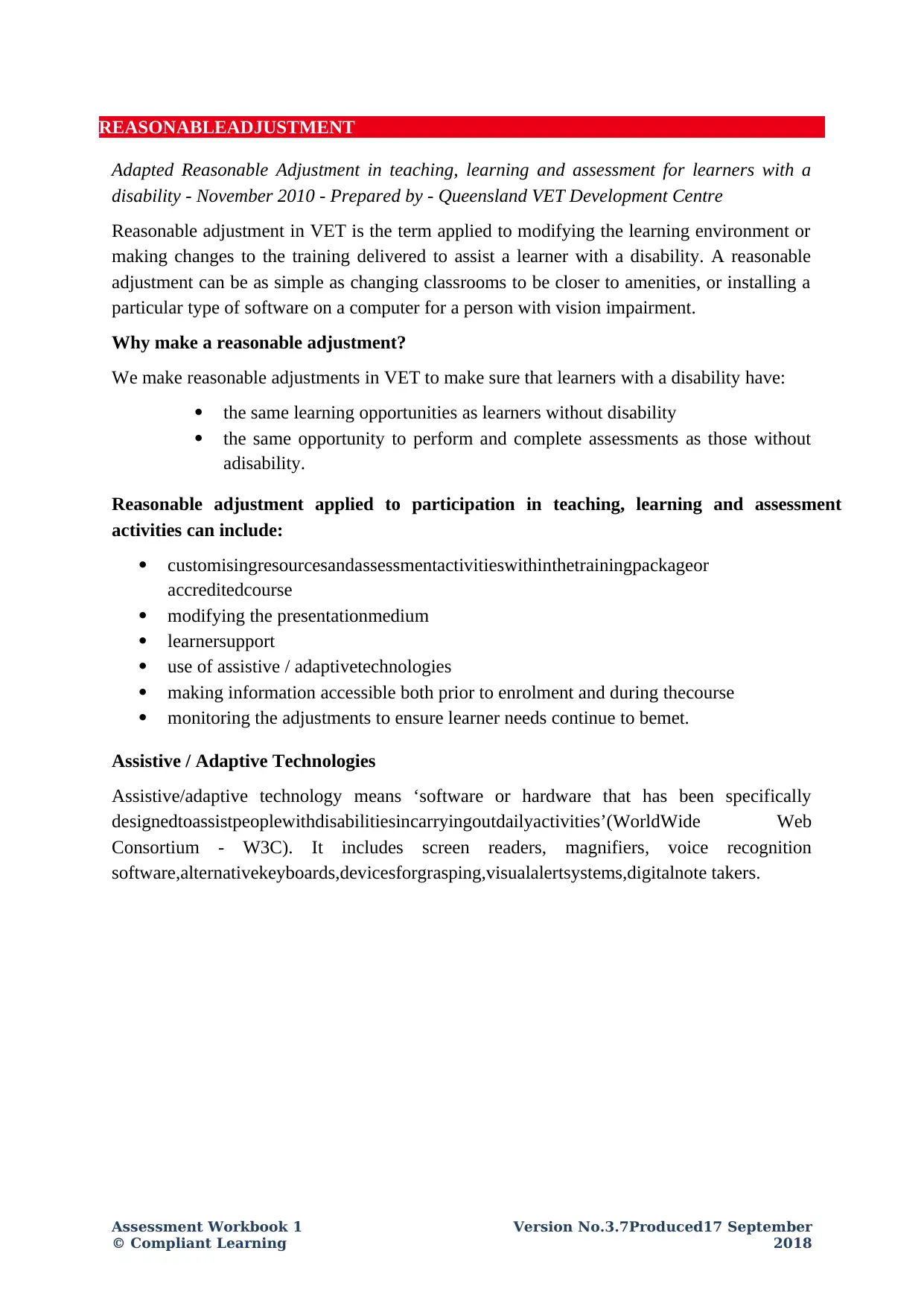
Assessment Workbook 1
© Compliant Learning
Resources
Version No.3.7Produced17 September
2018
Page9
REASONABLEADJUSTMENT
Adapted Reasonable Adjustment in teaching, learning and assessment for learners with a
disability - November 2010 - Prepared by - Queensland VET Development Centre
Reasonable adjustment in VET is the term applied to modifying the learning environment or
making changes to the training delivered to assist a learner with a disability. A reasonable
adjustment can be as simple as changing classrooms to be closer to amenities, or installing a
particular type of software on a computer for a person with vision impairment.
Why make a reasonable adjustment?
We make reasonable adjustments in VET to make sure that learners with a disability have:
the same learning opportunities as learners without disability
the same opportunity to perform and complete assessments as those without
adisability.
Reasonable adjustment applied to participation in teaching, learning and assessment
activities can include:
customisingresourcesandassessmentactivitieswithinthetrainingpackageor
accreditedcourse
modifying the presentationmedium
learnersupport
use of assistive / adaptivetechnologies
making information accessible both prior to enrolment and during thecourse
monitoring the adjustments to ensure learner needs continue to bemet.
Assistive / Adaptive Technologies
Assistive/adaptive technology means ‘software or hardware that has been specifically
designedtoassistpeoplewithdisabilitiesincarryingoutdailyactivities’(WorldWide Web
Consortium - W3C). It includes screen readers, magnifiers, voice recognition
software,alternativekeyboards,devicesforgrasping,visualalertsystems,digitalnote takers.
© Compliant Learning
Resources
Version No.3.7Produced17 September
2018
Page9
REASONABLEADJUSTMENT
Adapted Reasonable Adjustment in teaching, learning and assessment for learners with a
disability - November 2010 - Prepared by - Queensland VET Development Centre
Reasonable adjustment in VET is the term applied to modifying the learning environment or
making changes to the training delivered to assist a learner with a disability. A reasonable
adjustment can be as simple as changing classrooms to be closer to amenities, or installing a
particular type of software on a computer for a person with vision impairment.
Why make a reasonable adjustment?
We make reasonable adjustments in VET to make sure that learners with a disability have:
the same learning opportunities as learners without disability
the same opportunity to perform and complete assessments as those without
adisability.
Reasonable adjustment applied to participation in teaching, learning and assessment
activities can include:
customisingresourcesandassessmentactivitieswithinthetrainingpackageor
accreditedcourse
modifying the presentationmedium
learnersupport
use of assistive / adaptivetechnologies
making information accessible both prior to enrolment and during thecourse
monitoring the adjustments to ensure learner needs continue to bemet.
Assistive / Adaptive Technologies
Assistive/adaptive technology means ‘software or hardware that has been specifically
designedtoassistpeoplewithdisabilitiesincarryingoutdailyactivities’(WorldWide Web
Consortium - W3C). It includes screen readers, magnifiers, voice recognition
software,alternativekeyboards,devicesforgrasping,visualalertsystems,digitalnote takers.
⊘ This is a preview!⊘
Do you want full access?
Subscribe today to unlock all pages.

Trusted by 1+ million students worldwide
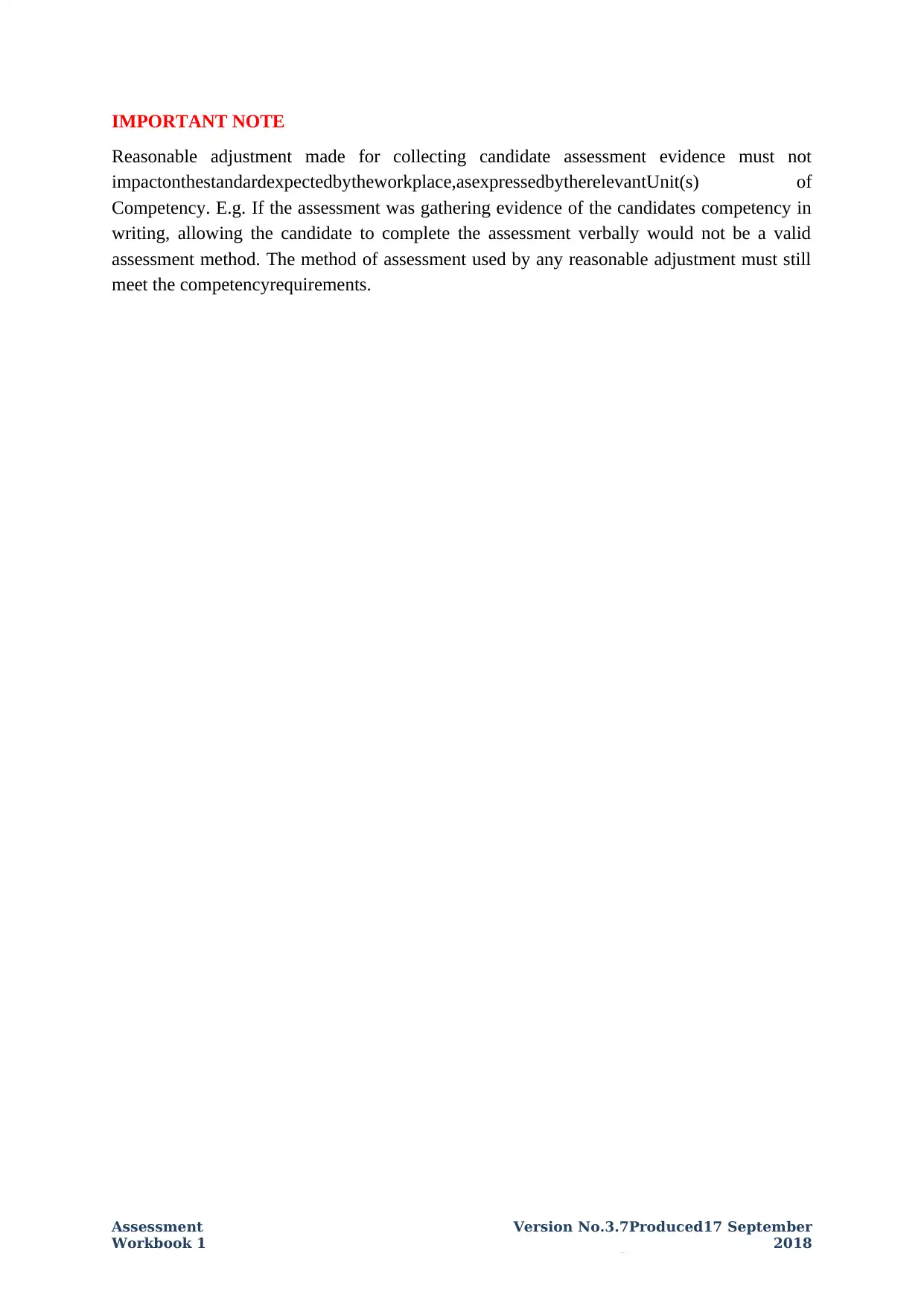
Assessment
Workbook 1
Page 10
Version No.3.7Produced17 September
2018
© Compliant LearningResources
IMPORTANT NOTE
Reasonable adjustment made for collecting candidate assessment evidence must not
impactonthestandardexpectedbytheworkplace,asexpressedbytherelevantUnit(s) of
Competency. E.g. If the assessment was gathering evidence of the candidates competency in
writing, allowing the candidate to complete the assessment verbally would not be a valid
assessment method. The method of assessment used by any reasonable adjustment must still
meet the competencyrequirements.
Workbook 1
Page 10
Version No.3.7Produced17 September
2018
© Compliant LearningResources
IMPORTANT NOTE
Reasonable adjustment made for collecting candidate assessment evidence must not
impactonthestandardexpectedbytheworkplace,asexpressedbytherelevantUnit(s) of
Competency. E.g. If the assessment was gathering evidence of the candidates competency in
writing, allowing the candidate to complete the assessment verbally would not be a valid
assessment method. The method of assessment used by any reasonable adjustment must still
meet the competencyrequirements.
Paraphrase This Document
Need a fresh take? Get an instant paraphrase of this document with our AI Paraphraser
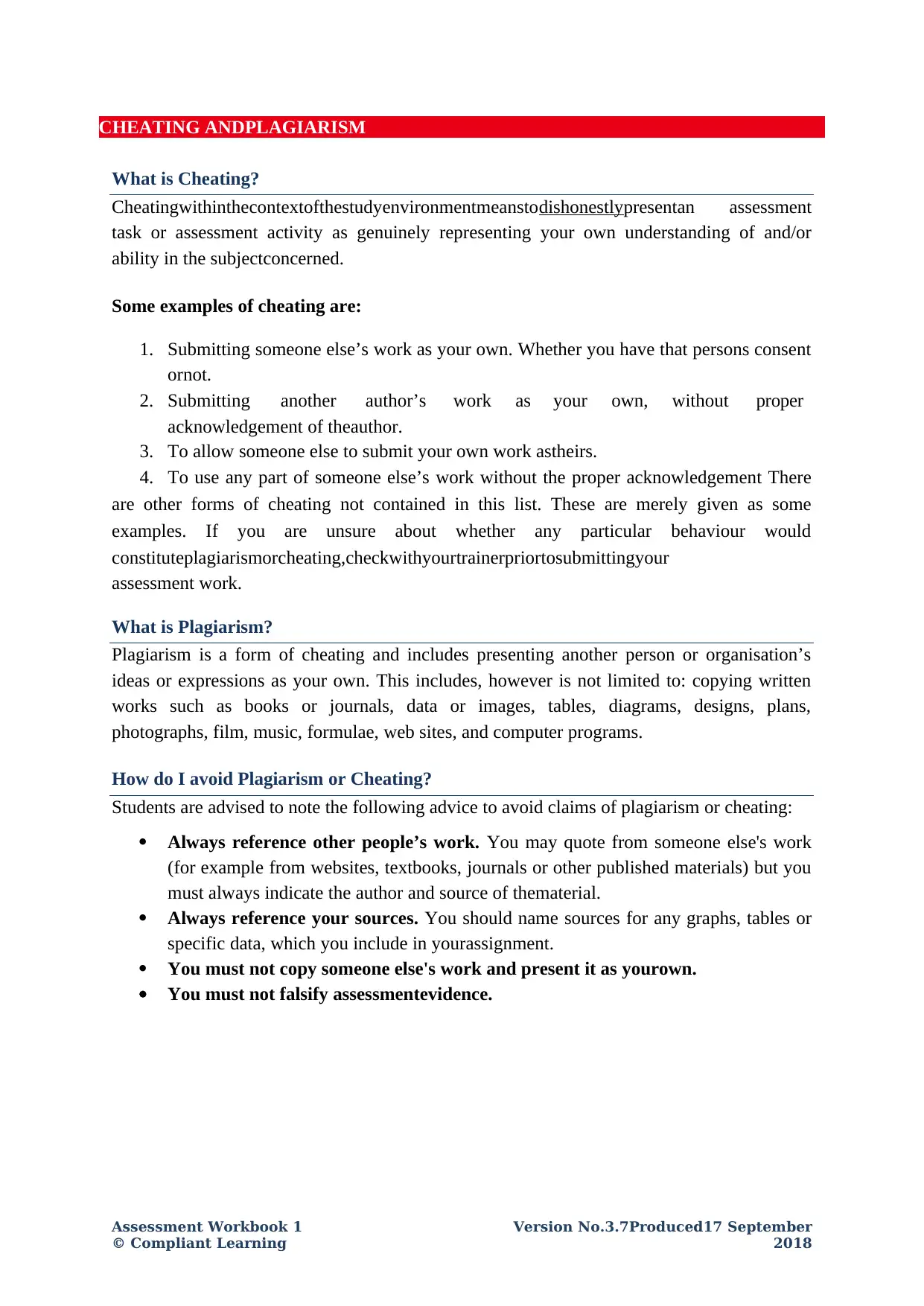
Assessment Workbook 1
© Compliant Learning
Resources
Version No.3.7Produced17 September
2018
Page11
CHEATING ANDPLAGIARISM
What is Cheating?
Cheatingwithinthecontextofthestudyenvironmentmeanstodishonestlypresentan assessment
task or assessment activity as genuinely representing your own understanding of and/or
ability in the subjectconcerned.
Some examples of cheating are:
1. Submitting someone else’s work as your own. Whether you have that persons consent
ornot.
2. Submitting another author’s work as your own, without proper
acknowledgement of theauthor.
3. To allow someone else to submit your own work astheirs.
4. To use any part of someone else’s work without the proper acknowledgement There
are other forms of cheating not contained in this list. These are merely given as some
examples. If you are unsure about whether any particular behaviour would
constituteplagiarismorcheating,checkwithyourtrainerpriortosubmittingyour
assessment work.
What is Plagiarism?
Plagiarism is a form of cheating and includes presenting another person or organisation’s
ideas or expressions as your own. This includes, however is not limited to: copying written
works such as books or journals, data or images, tables, diagrams, designs, plans,
photographs, film, music, formulae, web sites, and computer programs.
How do I avoid Plagiarism or Cheating?
Students are advised to note the following advice to avoid claims of plagiarism or cheating:
Always reference other people’s work. You may quote from someone else's work
(for example from websites, textbooks, journals or other published materials) but you
must always indicate the author and source of thematerial.
Always reference your sources. You should name sources for any graphs, tables or
specific data, which you include in yourassignment.
You must not copy someone else's work and present it as yourown.
You must not falsify assessmentevidence.
© Compliant Learning
Resources
Version No.3.7Produced17 September
2018
Page11
CHEATING ANDPLAGIARISM
What is Cheating?
Cheatingwithinthecontextofthestudyenvironmentmeanstodishonestlypresentan assessment
task or assessment activity as genuinely representing your own understanding of and/or
ability in the subjectconcerned.
Some examples of cheating are:
1. Submitting someone else’s work as your own. Whether you have that persons consent
ornot.
2. Submitting another author’s work as your own, without proper
acknowledgement of theauthor.
3. To allow someone else to submit your own work astheirs.
4. To use any part of someone else’s work without the proper acknowledgement There
are other forms of cheating not contained in this list. These are merely given as some
examples. If you are unsure about whether any particular behaviour would
constituteplagiarismorcheating,checkwithyourtrainerpriortosubmittingyour
assessment work.
What is Plagiarism?
Plagiarism is a form of cheating and includes presenting another person or organisation’s
ideas or expressions as your own. This includes, however is not limited to: copying written
works such as books or journals, data or images, tables, diagrams, designs, plans,
photographs, film, music, formulae, web sites, and computer programs.
How do I avoid Plagiarism or Cheating?
Students are advised to note the following advice to avoid claims of plagiarism or cheating:
Always reference other people’s work. You may quote from someone else's work
(for example from websites, textbooks, journals or other published materials) but you
must always indicate the author and source of thematerial.
Always reference your sources. You should name sources for any graphs, tables or
specific data, which you include in yourassignment.
You must not copy someone else's work and present it as yourown.
You must not falsify assessmentevidence.
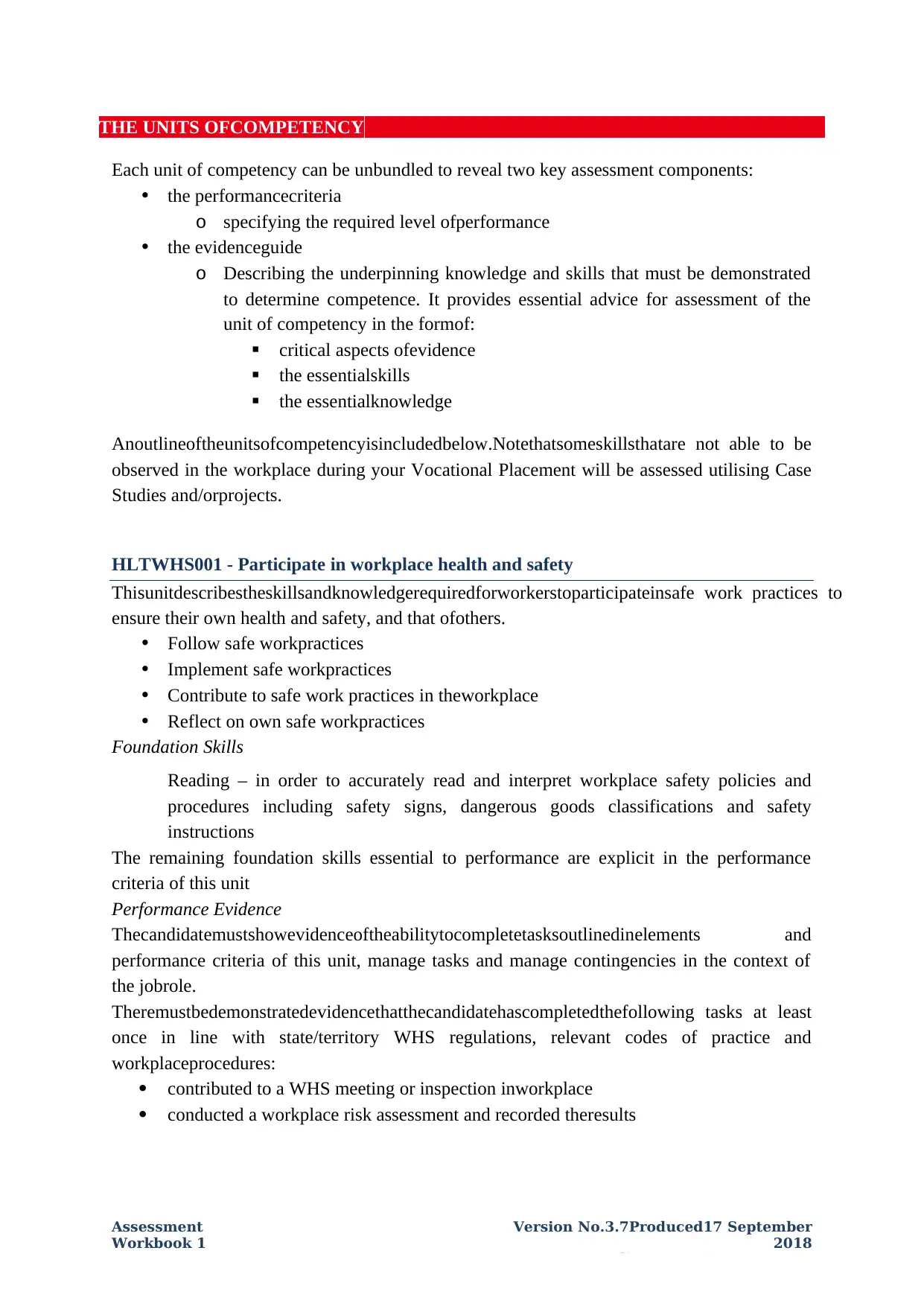
Version No.3.7Produced17 September
2018
© Compliant LearningResources
Assessment
Workbook 1
Page 12
THE UNITS OFCOMPETENCY
Each unit of competency can be unbundled to reveal two key assessment components:
• the performancecriteria
o specifying the required level ofperformance
• the evidenceguide
o Describing the underpinning knowledge and skills that must be demonstrated
to determine competence. It provides essential advice for assessment of the
unit of competency in the formof:
critical aspects ofevidence
the essentialskills
the essentialknowledge
Anoutlineoftheunitsofcompetencyisincludedbelow.Notethatsomeskillsthatare not able to be
observed in the workplace during your Vocational Placement will be assessed utilising Case
Studies and/orprojects.
HLTWHS001 - Participate in workplace health and safety
Thisunitdescribestheskillsandknowledgerequiredforworkerstoparticipateinsafe work practices to
ensure their own health and safety, and that ofothers.
• Follow safe workpractices
• Implement safe workpractices
• Contribute to safe work practices in theworkplace
• Reflect on own safe workpractices
Foundation Skills
Reading – in order to accurately read and interpret workplace safety policies and
procedures including safety signs, dangerous goods classifications and safety
instructions
The remaining foundation skills essential to performance are explicit in the performance
criteria of this unit
Performance Evidence
Thecandidatemustshowevidenceoftheabilitytocompletetasksoutlinedinelements and
performance criteria of this unit, manage tasks and manage contingencies in the context of
the jobrole.
Theremustbedemonstratedevidencethatthecandidatehascompletedthefollowing tasks at least
once in line with state/territory WHS regulations, relevant codes of practice and
workplaceprocedures:
contributed to a WHS meeting or inspection inworkplace
conducted a workplace risk assessment and recorded theresults
2018
© Compliant LearningResources
Assessment
Workbook 1
Page 12
THE UNITS OFCOMPETENCY
Each unit of competency can be unbundled to reveal two key assessment components:
• the performancecriteria
o specifying the required level ofperformance
• the evidenceguide
o Describing the underpinning knowledge and skills that must be demonstrated
to determine competence. It provides essential advice for assessment of the
unit of competency in the formof:
critical aspects ofevidence
the essentialskills
the essentialknowledge
Anoutlineoftheunitsofcompetencyisincludedbelow.Notethatsomeskillsthatare not able to be
observed in the workplace during your Vocational Placement will be assessed utilising Case
Studies and/orprojects.
HLTWHS001 - Participate in workplace health and safety
Thisunitdescribestheskillsandknowledgerequiredforworkerstoparticipateinsafe work practices to
ensure their own health and safety, and that ofothers.
• Follow safe workpractices
• Implement safe workpractices
• Contribute to safe work practices in theworkplace
• Reflect on own safe workpractices
Foundation Skills
Reading – in order to accurately read and interpret workplace safety policies and
procedures including safety signs, dangerous goods classifications and safety
instructions
The remaining foundation skills essential to performance are explicit in the performance
criteria of this unit
Performance Evidence
Thecandidatemustshowevidenceoftheabilitytocompletetasksoutlinedinelements and
performance criteria of this unit, manage tasks and manage contingencies in the context of
the jobrole.
Theremustbedemonstratedevidencethatthecandidatehascompletedthefollowing tasks at least
once in line with state/territory WHS regulations, relevant codes of practice and
workplaceprocedures:
contributed to a WHS meeting or inspection inworkplace
conducted a workplace risk assessment and recorded theresults
⊘ This is a preview!⊘
Do you want full access?
Subscribe today to unlock all pages.

Trusted by 1+ million students worldwide
1 out of 134
Related Documents
Your All-in-One AI-Powered Toolkit for Academic Success.
+13062052269
info@desklib.com
Available 24*7 on WhatsApp / Email
![[object Object]](/_next/static/media/star-bottom.7253800d.svg)
Unlock your academic potential
Copyright © 2020–2025 A2Z Services. All Rights Reserved. Developed and managed by ZUCOL.





